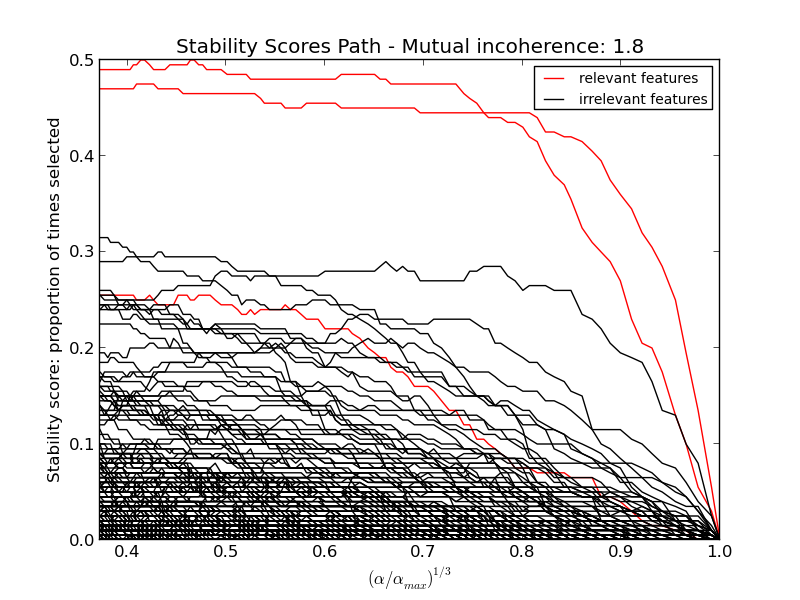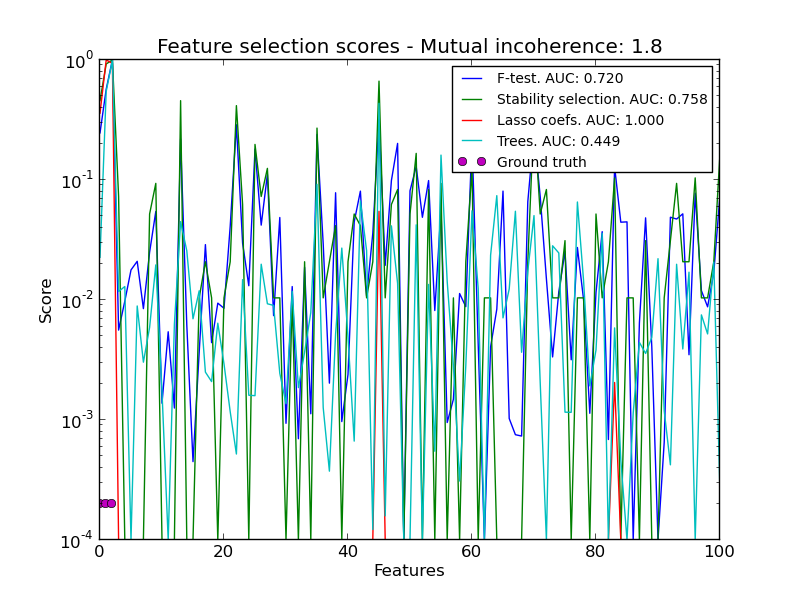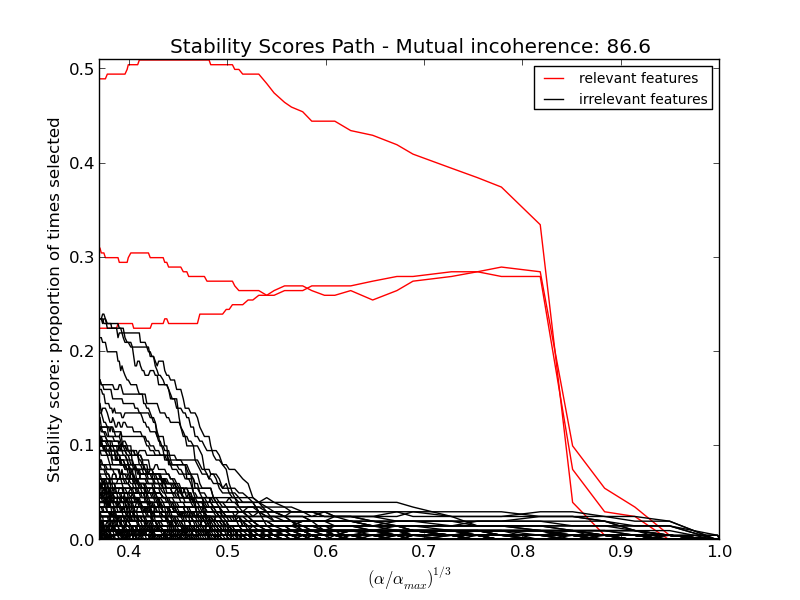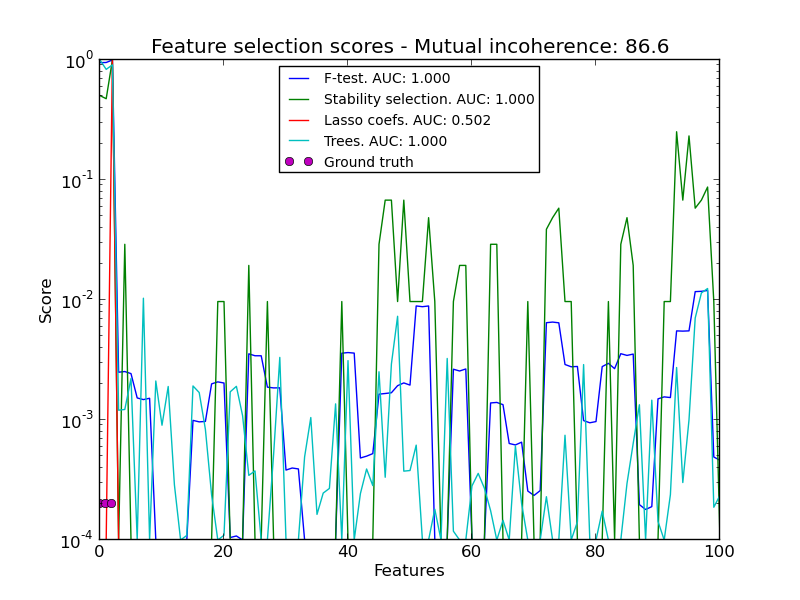Sparse recovery: feature selection for sparse linear models¶
Given a small number of observations, we want to recover which features of X are relevant to explain y. For this sparse linear models can outperform standard statistical tests if the true model is sparse, i.e. if a small fraction of the features are relevant.
As detailed in the compressive sensing notes, the ability of L1-based approach to identify the relevant variables depends on the sparsity of the ground truth, the number of samples, the number of features, the conditioning of the design matrix on the signal subspace, the amount of noise, and the absolute value of the smallest non-zero coefficient [Wainwright2006] (http://statistics.berkeley.edu/tech-reports/709.pdf).
Here we keep all parameters constant and vary the conditioning of the design matrix. For a well-conditioned design matrix (small mutual incoherence) we are exactly in compressive sensing conditions (i.i.d Gaussian sensing matrix), and L1-recovery with the Lasso performs very well. For an ill-conditioned matrix (high mutual incoherence), regressors are very correlated, and the Lasso randomly selects one. However, randomized-Lasso can recover the ground truth well.
In each situation, we first vary the alpha parameter setting the sparsity of the estimated model and look at the stability scores of the randomized Lasso. This analysis, knowing the ground truth, shows an optimal regime in which relevant features stand out from the irrelevant ones. If alpha is chosen too small, non-relevant variables enter the model. On the opposite, if alpha is selected too large, the Lasso is equivalent to stepwise regression, and thus brings no advantage over a univariate F-test.
In a second time, we set alpha and compare the performance of different feature selection methods, using the area under curve (AUC) of the precision-recall.
Python source code: plot_sparse_recovery.py
print(__doc__)
# Author: Alexandre Gramfort and Gael Varoquaux
# License: BSD 3 clause
import warnings
import matplotlib.pyplot as plt
import numpy as np
from scipy import linalg
from sklearn.linear_model import (RandomizedLasso, lasso_stability_path,
LassoLarsCV)
from sklearn.feature_selection import f_regression
from sklearn.preprocessing import StandardScaler
from sklearn.metrics import auc, precision_recall_curve
from sklearn.ensemble import ExtraTreesRegressor
from sklearn.utils.extmath import pinvh
from sklearn.exceptions import ConvergenceWarning
def mutual_incoherence(X_relevant, X_irelevant):
"""Mutual incoherence, as defined by formula (26a) of [Wainwright2006].
"""
projector = np.dot(np.dot(X_irelevant.T, X_relevant),
pinvh(np.dot(X_relevant.T, X_relevant)))
return np.max(np.abs(projector).sum(axis=1))
for conditioning in (1, 1e-4):
###########################################################################
# Simulate regression data with a correlated design
n_features = 501
n_relevant_features = 3
noise_level = .2
coef_min = .2
# The Donoho-Tanner phase transition is around n_samples=25: below we
# will completely fail to recover in the well-conditioned case
n_samples = 25
block_size = n_relevant_features
rng = np.random.RandomState(42)
# The coefficients of our model
coef = np.zeros(n_features)
coef[:n_relevant_features] = coef_min + rng.rand(n_relevant_features)
# The correlation of our design: variables correlated by blocs of 3
corr = np.zeros((n_features, n_features))
for i in range(0, n_features, block_size):
corr[i:i + block_size, i:i + block_size] = 1 - conditioning
corr.flat[::n_features + 1] = 1
corr = linalg.cholesky(corr)
# Our design
X = rng.normal(size=(n_samples, n_features))
X = np.dot(X, corr)
# Keep [Wainwright2006] (26c) constant
X[:n_relevant_features] /= np.abs(
linalg.svdvals(X[:n_relevant_features])).max()
X = StandardScaler().fit_transform(X.copy())
# The output variable
y = np.dot(X, coef)
y /= np.std(y)
# We scale the added noise as a function of the average correlation
# between the design and the output variable
y += noise_level * rng.normal(size=n_samples)
mi = mutual_incoherence(X[:, :n_relevant_features],
X[:, n_relevant_features:])
###########################################################################
# Plot stability selection path, using a high eps for early stopping
# of the path, to save computation time
alpha_grid, scores_path = lasso_stability_path(X, y, random_state=42,
eps=0.05)
plt.figure()
# We plot the path as a function of alpha/alpha_max to the power 1/3: the
# power 1/3 scales the path less brutally than the log, and enables to
# see the progression along the path
hg = plt.plot(alpha_grid[1:] ** .333, scores_path[coef != 0].T[1:], 'r')
hb = plt.plot(alpha_grid[1:] ** .333, scores_path[coef == 0].T[1:], 'k')
ymin, ymax = plt.ylim()
plt.xlabel(r'$(\alpha / \alpha_{max})^{1/3}$')
plt.ylabel('Stability score: proportion of times selected')
plt.title('Stability Scores Path - Mutual incoherence: %.1f' % mi)
plt.axis('tight')
plt.legend((hg[0], hb[0]), ('relevant features', 'irrelevant features'),
loc='best')
###########################################################################
# Plot the estimated stability scores for a given alpha
# Use 6-fold cross-validation rather than the default 3-fold: it leads to
# a better choice of alpha:
# Stop the user warnings outputs- they are not necessary for the example
# as it is specifically set up to be challenging.
with warnings.catch_warnings():
warnings.simplefilter('ignore', UserWarning)
warnings.simplefilter('ignore', ConvergenceWarning)
lars_cv = LassoLarsCV(cv=6).fit(X, y)
# Run the RandomizedLasso: we use a paths going down to .1*alpha_max
# to avoid exploring the regime in which very noisy variables enter
# the model
alphas = np.linspace(lars_cv.alphas_[0], .1 * lars_cv.alphas_[0], 6)
clf = RandomizedLasso(alpha=alphas, random_state=42).fit(X, y)
trees = ExtraTreesRegressor(100).fit(X, y)
# Compare with F-score
F, _ = f_regression(X, y)
plt.figure()
for name, score in [('F-test', F),
('Stability selection', clf.scores_),
('Lasso coefs', np.abs(lars_cv.coef_)),
('Trees', trees.feature_importances_),
]:
precision, recall, thresholds = precision_recall_curve(coef != 0,
score)
plt.semilogy(np.maximum(score / np.max(score), 1e-4),
label="%s. AUC: %.3f" % (name, auc(recall, precision)))
plt.plot(np.where(coef != 0)[0], [2e-4] * n_relevant_features, 'mo',
label="Ground truth")
plt.xlabel("Features")
plt.ylabel("Score")
# Plot only the 100 first coefficients
plt.xlim(0, 100)
plt.legend(loc='best')
plt.title('Feature selection scores - Mutual incoherence: %.1f'
% mi)
plt.show()
Total running time of the example: 6.08 seconds ( 0 minutes 6.08 seconds)





